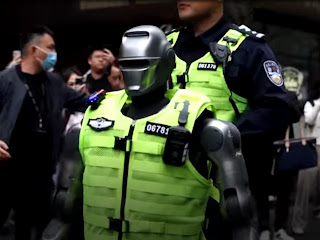In a scene straight out of a sci-fi blockbuster, a major Chinese city has unveiled its newest crime-fighting tool: a humanoid robot patrolling bustling streets, interacting with citizens, and scanning crowds for suspicious activity. Dubbed "Guardian X1" by local authorities, the autonomous machine represents a bold leap into the future of law enforcement—and has ignited global fascination and debate.
A Next-Generation Officer on Duty
Standing at 5 feet 7 inches tall, the sleek, white-and-blue robot is equipped with advanced artificial intelligence, facial recognition software, and real-time data analysis capabilities. Designed to assist human officers, it can identify wanted criminals, detect unattended objects, and even issue verbal warnings to rule-breakers. The bot’s 360-degree cameras and sensors allow it to navigate crowded areas like subway stations and shopping districts autonomously, while its multilingual interface helps tourists with directions or emergency requests.
Watch the Guardian X1 in action here, where footage shows the robot calmly addressing a lost pedestrian and flagging a suspicious bag to human counterparts.
Public Reactions: Awe and Anxiety
While the deployment aims to enhance safety and efficiency, it has sparked mixed reactions. "It’s impressive, but a little unsettling," admitted Li Wei, a local shopkeeper. "Seeing a machine enforce rules feels… impersonal." Others praised its 24/7 presence, particularly in high-risk areas.
Behind the scenes, the technology has also stirred online debates. On Reddit’s robotics forum, users dissect its capabilities, with some questioning privacy implications. "Facial recognition in public spaces is a slippery slope," argued one commenter, while others applauded its potential to reduce officer workload.
Balancing Innovation and Ethics
Police spokesperson Zhang Hao emphasized that Guardian X1 operates under strict protocols. "It cannot make arrests or use force," he clarified. "Its role is deterrence, data collection, and support." Still, critics warn of mission creep. Dr. Elena Torres, an AI ethics researcher, noted, "Without transparent guidelines, such tools risk normalizing surveillance overreach."
China’s push into robotic policing mirrors global trends, with cities like Dubai and Tokyo testing similar systems. Yet Guardian X1’s humanoid design—a deliberate choice to foster public familiarity—sets it apart.
The Future of Policing?
As China invests heavily in AI-driven security, Guardian X1 may soon have company. Developers hint at future models capable of hostage negotiation or disaster response. For now, the experiment raises pivotal questions: Will robots make policing fairer—or colder? Can technology outpace ethical safeguards?
One thing is certain: the age of RoboCop is no longer fiction. It’s patrolling the streets, one algorithm at a time.
